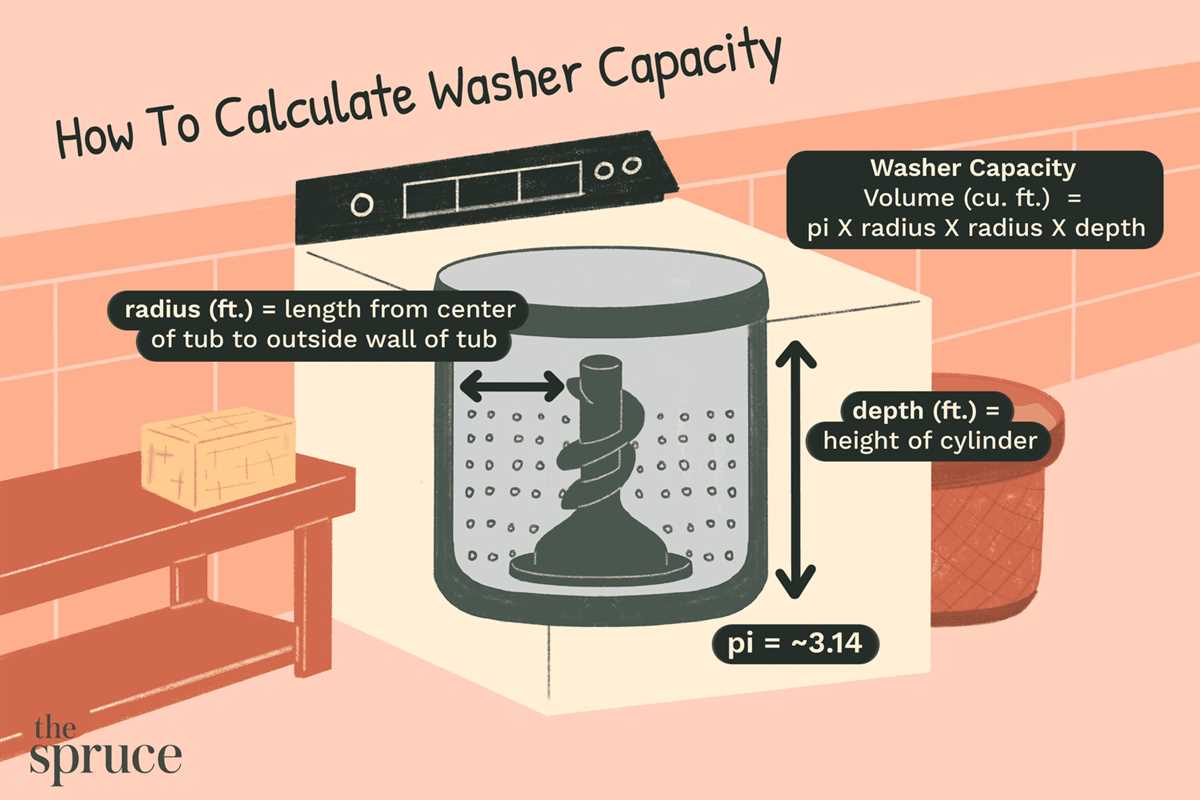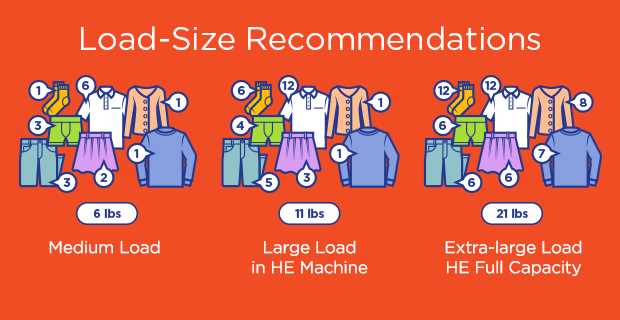




Doing laundry is a routine part of maintaining a clean and organized home. Whether you choose to wash your clothes by hand or use a washing machine, determining the appropriate load size is essential for efficient cleaning and water conservation. But what exactly is considered a small load of laundry?
In general, a small load of laundry is typically defined as filling up to one-third of the washing machine’s capacity. This usually means that the laundry is enough to cover the bottom of the drum, but not so much that it exceeds the recommended weight limit. It is important to note that the specific capacity will vary depending on the size and model of your washing machine.
It is highly recommended to consult your washing machine’s user manual to determine the exact capacity and weight limit for your appliance. Overloading the machine can lead to poor cleaning results, excessive wear on the machine, and potential damage to both the machine and your clothes. On the other hand, underloading the machine means wasting water and energy, which is not cost-effective or environmentally friendly.
To ensure the best results and save time and resources, it is advisable to separate your laundry into small, medium, and large loads. Small loads are ideal for delicate or lightly soiled items that require gentle care, while larger loads are more suitable for heavier or heavily soiled clothing. By following these guidelines, you can optimize your laundry routine and achieve clean, fresh-smelling clothes every time.
What Is Considered a Small Load of Laundry?

When it comes to doing laundry, it’s important to understand what is considered a small load. This knowledge can help you optimize your laundry process, save time and energy, and ensure the best results for your clothes.
A small load of laundry is typically defined as a load that fills up approximately one-third to half of the washing machine’s capacity. This can vary depending on the size and type of your washing machine, but as a general guideline, a standard front-loading machine with a capacity of 7-8 kilograms can accommodate a small load.
Here are some factors to consider when determining if your laundry load is small:
- Weight: A small load should be light enough for the machine to agitate and clean effectively. If your load feels heavy or bulky, it may be too large for a small load.
- Space: A small load should leave enough space for the clothes to move around freely inside the machine. Overloading the machine can lead to inadequate cleaning and potential damage to your clothes.
- Water and detergent usage: A small load requires less water and detergent compared to a larger load. Using the correct amount of water and detergent can help ensure that your clothes are properly cleaned without wasting resources.
Additionally, consider the specific instructions provided by your washing machine manufacturer. They may have recommendations or settings specifically designed for small loads.
Benefits of doing small loads include shorter washing and drying times, reduced energy and water usage, and better cleaning results. By separating your laundry into small loads, you can also avoid mixing clothes of different colors or fabric types, reducing the risk of color bleeding or damage.
However, keep in mind that doing too many small loads can be time-consuming, especially if your washing machine has a limited capacity. It’s important to find a balance that works for you and your laundry needs.
Tips for Optimizing Small Loads:
- Sort your laundry: Separate your clothes by color, fabric type, and level of dirtiness to ensure the best cleaning results.
- Use the correct amount of detergent: Read the instructions on your detergent packaging and measure accordingly. Using too little detergent may not fully clean your clothes, while using too much can lead to excess suds and residue.
- Adjust water temperature: Different fabrics require different water temperatures for optimal cleaning. Check the care labels on your clothes and set the washing machine to the appropriate temperature.
- Don’t overload the machine: Even with small loads, it’s important not to overload the machine. Leave enough space for the clothes to move around freely.
- Consider using a laundry booster: For heavily soiled items or extra freshness, you can add a laundry booster like baking soda or oxygen bleach to your small load.
In conclusion, a small load of laundry fills up approximately one-third to half of the washing machine’s capacity. By following these guidelines and tips, you can ensure the best results, save time and resources, and keep your clothes looking their best.
Understanding Laundry Load Sizes
When it comes to doing laundry, it’s important to understand the concept of load sizes. Knowing what constitutes a small load of laundry can help you optimize your laundry routine and ensure the best results from your washing machine.
Factors Affecting Load Size
The size of a laundry load can vary depending on several factors:
- Machine Capacity: The capacity of your washing machine plays a significant role in determining load sizes. Each washing machine has a specified maximum load capacity, usually measured in pounds or kilograms. It’s important to check your machine’s user manual or specifications to know its capacity.
- Type of Clothing: Different types of clothing have different weights and sizes. For example, a load consisting of heavy denim jeans will be smaller compared to a load of lightweight t-shirts.
- Soil Level: Load sizes may also depend on the level of dirt or staining on the clothes. Heavily soiled items may require more space for effective cleaning.
- Fabric Type: Certain fabrics, such as blankets or towels, are bulkier and take up more space in the washing machine. This can affect the load size.
- Water Efficiency: In an effort to conserve water, newer washing machines have become more water-efficient. This means that smaller loads may be required to achieve optimal water usage.
Identifying a Small Load
A small load of laundry typically consists of approximately 3-4 pounds or 1.4-1.8 kilograms of clothing. This can vary depending on the factors mentioned above, but it serves as a general guideline. It’s always a good idea to refer to your machine’s user manual for specific load size recommendations.
Benefits of Proper Load Sizing

Understanding load sizes and properly sizing your laundry loads can offer several benefits:
- Energy Efficiency: Smaller loads require less energy to wash and dry, resulting in lower utility bills.
- Water Conservation: Using the optimal load size helps reduce water waste and promotes water conservation.
- Better Cleaning Performance: Overloading the washing machine can hinder proper agitation and cleaning. Proper load sizing ensures that clothes have enough space to move freely for optimal cleaning.
- Reduced Wear and Tear: Overloading the washing machine can put excessive strain on the drum and other components, reducing the lifespan of the appliance. Proper load sizing helps prevent unnecessary damage.
Conclusion
Understanding laundry load sizes is essential for efficient and effective laundry routines. By considering factors like machine capacity, clothing type, soil level, fabric type, and water efficiency, you can determine the appropriate load size for your laundry needs. Proper load sizing offers benefits like energy efficiency, water conservation, better cleaning performance, and reduced wear and tear on your washing machine. Always consult your machine’s user manual for specific load size recommendations.
Benefits of Doing Small Loads

1. Energy Efficiency:
One of the main benefits of doing small loads of laundry is that it can help save energy. When you only wash a small amount of clothes, you don’t need to use as much water or detergent, and you can also reduce the amount of power used by your washing machine.
2. Time Efficiency:
Small loads of laundry require less time to wash and dry compared to larger loads. This can be beneficial if you’re in a hurry or have limited time available for doing laundry. By doing small loads frequently, you can keep up with your laundry without feeling overwhelmed.
3. Reduced Wrinkling:
When you have a small load of clothes in the washing machine, there’s more space for the items to move around freely. This can help prevent excessive wrinkling, leaving your clothes looking neater and requiring less ironing or steaming.
4. Better Cleaning:
Small loads allow for better agitation and movement of clothes during the washing process. This can result in more thorough cleaning and stain removal, as each item has more room to interact with the water and detergent. It can also help prevent clothes from becoming tangled or twisted.
5. Versatility:
Small loads offer more flexibility in terms of choosing different wash cycles and water temperature settings. You can customize each load based on the specific requirements of the clothes you’re washing, whether it’s delicate, heavily soiled, or lightly soiled items.
6. Conservation of Resources:
By doing small loads, you can conserve resources such as water and detergent. This not only benefits the environment but also helps reduce your household expenses in the long run.
Overall, doing small loads of laundry can bring several benefits, including energy and time efficiency, reduced wrinkling, better cleaning, versatility, and resource conservation. So, don’t hesitate to divide your laundry into smaller loads to enjoy these advantages.
Tips for Efficient Small Loads
Doing smaller loads of laundry can be more efficient in terms of time, energy, and water usage. Here are some tips to help you make the most out of your small loads:
- Sort your laundry: Even with small loads, it’s still important to sort your laundry by color and fabric type. This will help prevent color bleeding and damage to delicate fabrics.
- Adjust water level and cycle settings: Most washing machines have options to adjust the water level and cycle settings based on the load size. Make sure to choose the appropriate settings for your small load to avoid wasted water and energy.
- Use the appropriate amount of detergent: Follow the instructions on the detergent packaging to determine the correct amount to use for your small load. Using too much detergent can lead to excess suds and make rinsing more difficult.
- Consider using a shorter wash cycle: If your clothes aren’t heavily soiled, you may be able to use a shorter wash cycle for your small load. This can help save time and energy.
- Avoid overcrowding the machine: While it can be tempting to fit as much as possible into a small load, avoid overcrowding the machine. Clothes need space to move around freely for optimal cleaning.
- Use a higher spin speed: A higher spin speed can help remove more water from your small load, reducing drying time. Check your washing machine’s manual for guidance on selecting the appropriate spin speed.
- Air dry when possible: Taking advantage of sunny days and air drying your small load can save energy and help preserve the lifespan of your clothes. Consider investing in a drying rack or clothesline.
- Consider wash-and-wear fabrics: When shopping for clothes, look for items labeled as wash-and-wear or easy care. These fabrics are designed to be low-maintenance and require less ironing or special care.
By implementing these tips, you can make your small loads of laundry more efficient while still achieving clean and fresh-smelling clothes.
How to Determine the Right Load Size
Determining the right load size for your laundry is essential to ensure efficiency and proper cleaning. Here are some methods you can use to determine the right load size:
1. Check the manufacturer’s instructions
The first step in determining the right load size is to check the manufacturer’s instructions. Each washing machine has a recommended load capacity, which is typically measured in pounds or kilograms. It is important to follow these guidelines to avoid overloading the machine and potentially damaging it.
2. Consider the type of clothing

The type of clothing you are washing can also determine the right load size. Bulky items like blankets and towels may require a smaller load size, as they take up more space and need room to move around for proper cleaning. Delicate items, on the other hand, may require a larger load size to prevent excessive agitation.
3. Fill the drum without overpacking

A common rule of thumb is to fill the drum of the washing machine without overpacking it. You should be able to fit your hand comfortably between the top of the laundry and the top of the drum. This allows for proper agitation and rinsing during the wash cycle.
4. Use weight as a guide

If you don’t have the manufacturer’s instructions or are unsure about the load size, you can use weight as a guide. A small load is typically around 3-4 pounds (1.4-1.8 kilograms), while a medium load is around 6-8 pounds (2.7-3.6 kilograms). A large load is usually 10 pounds (4.5 kilograms) or more. However, it is important to refer to the specific guidelines for your washing machine.
5. Avoid overcrowding

Finally, it is important to avoid overcrowding the washing machine. Overloading can lead to inadequate cleaning and improper rinsing. It can also put unnecessary strain on the machine, potentially causing it to malfunction or break down. Make sure there is enough space for the laundry to move freely and for the detergent and water to circulate effectively.
By following these guidelines and using common sense, you can determine the right load size for your laundry and ensure optimal results from your washing machine.
FAQ
What is considered a small load of laundry?
A small load of laundry is generally considered to be around 3-5 pounds of clothing. It can vary depending on the size of the washing machine, but this is a common guideline.
How do I know if I have a small load of laundry?
You can tell if you have a small load of laundry by weighing it on a scale. If it is around 3-5 pounds, then it is considered a small load.
Can I mix different types of clothing in a small load of laundry?
Yes, you can mix different types of clothing in a small load of laundry. Just make sure not to overload the washing machine and leave enough space for the clothes to move around and get properly cleaned.
Is it more energy efficient to do smaller loads of laundry?
Yes, doing smaller loads of laundry can be more energy efficient. It takes less time and water to wash and dry a smaller load, which can help save on energy costs.
How often should I do small loads of laundry?
The frequency of doing small loads of laundry depends on your personal needs and preferences. Some people prefer to do small loads more frequently to keep up with their laundry, while others may prefer to do larger loads less often. It is up to you to find a schedule that works best for you.
How do you define a small load of laundry?
A small load of laundry can be defined as a load that fills up about one-third to one-half of your washing machine’s capacity. It typically includes a few clothing items or a couple of small towels.
Can I wash just a single item of clothing?
Yes, you can wash just a single item of clothing if needed. However, it is not the most efficient use of water and energy. It is better to wait until you have enough clothes to make a small load.














